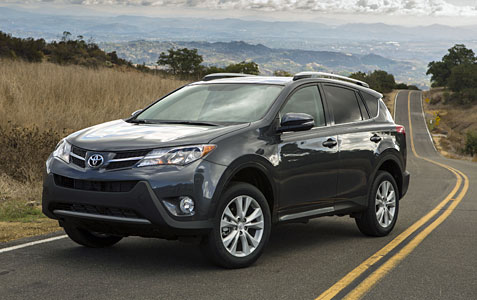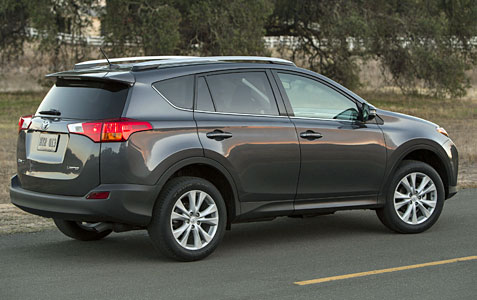Car Review: 2013 Toyota RAV4 XLE AWD

From first glance last year, one could tell there was something special about Toyota’s fourth-generation RAV4. We spent a week driving the 2013 Toyota RAV4 XLE AWD in some pretty harsh weather conditions and this SUV knows how to handle snow and sleet.
The new RAV4’s design achieves strong proportions while conveying the agile and fun character. Sophisticated and dynamic, the exterior features a progressive silhouette, with a sleek-sloping roofline and an aggressive character line. The RAV4 pursues a modern design with aggressively sculpted front and rear fenders and boldly proportioned taillights that define itsathletic presence. The stance looks stronger and much more in tuned with today’s customers.
In a significant break with its heritage, the RAV4 switches from its side-hinged rear door to a convenient roof-hinged liftgate with a space-saver spare tire will be stored under the cargo floor. Standard on the Limited grade is a one-touch power rear liftgate with driver-selectable memory height settings. As on other recently introduced Toyotas, RAV4 engineers paid special attention to aerodynamics — the most obvious detail being small vortex generators molded into the taillight cases and near the base of the A-pillars. Less obvious are the aerodynamic undertrays beneath the passenger cabin that help smooth and control airflow. From the 17-inch alloy wheels, to the Barcelona red metallic paint, the RAV4 has a skin that is light years ahead of past models when it comes to styling and substance.
The RAV4 XLE model we tested did not have leather seating, or heated seats, for that matter, but the new cabin was nonetheless very impressive. The new RAV4’s dash panel is driver-centric and asymmetrical, with primary and secondary controls all within easy reach. On the passenger side, the sculpted dash panel creates a sense of airy spaciousness.
The RAV4’s dash panel and gauges all feature Clear Blue illumination, which provides crisp visibility in most ambient light conditions, and a unified, coherent appearance at night. The RAV4 XLE driver and front passenger ride in premium bucket seats with sport bolstering, providing ample support of the lower hips, lower torso and shoulders during cornering. The XLE has premium fabric with French stitching on the seats and portions of the dash panels. All RAV4s feature 60/40 split/fold second-row seats that recline several degrees to enhance passenger comfort. In contrast to the 2013 RAV4’s compact exterior dimensions, the cargo area is deeper, larger and easier to access than in the previous generation, with just over 38.4 cu. ft. of cargo capacity behind the rear seats. With rear seats folded, the RAV4 has a maximum cargo capacity of 73.4 cu. ft. This is a very large area, and you really need to see the back seats folded down to appreciate this space.
Privacy glass, Daytime Running Lights (DRL), cruise control, power side mirrors, power door locks and power windows are standard on all RAV4s. Our test RAV4 XLE featured dual-zone automatic climate control, integrated fog lights, power moonroof with sliding sunshade and heated outside mirrors with turn signal indicators. Standard on all RAV4 models is a Display Audio with a 6.1-inch LCD touchscreen. Significant for this market, the RAV4’s Display Audio includes a standard backup camera and Bluetooth connectivity. When shifted into reverse, the audio display shows the image of what the backup camera captures. The image includes an overlay of positioning lines representing the parking space and approximate distance to obstacles.
The XLEs also offer an available GPS Navigation and Entune multimedia system with satellite radio and advanced voice recognition. The Limited grade will also include an available JBL GreenEdge Premium Audio with 576-Watts of maximum power, 11 speakers, and GPS Navigation and Entune. The available Blind Spot Monitor incorporates Rear Cross Traffic Alert (RCTA), which uses the Blind Spot Monitor radar sensors at the lower rear bodywork of the vehicle. When backing up, the RCTA senses vehicles approaching from either direction and provides an audible warning combined with a flashing indicator in the appropriate outside mirror.

The 2013 Toyota RAV4 XLE provides a number of powertrain technologies that help deliver an engaging driving experience. Our test model featured Toyota’s 2.5-liter four-cylinder, which produces 176 horsepower at 6,000 rpm and 172 ft. lbs. of torque at 4,100 rpm. The optional V6 of the previous-generation RAV4 was discontinued.
Replacing the previous four-speed automatic is a six-speed transmission with Sequential Shift. First and second gear ratios are optimized for around-town performance. To keep engine revs lower at highway speeds and enhance fuel mileage, fifth and sixth gears will be overdrives. The new RAV4 provides its active owners a more dynamic drive, with new technologies like a Sport Mode with Dynamic Torque Control AWD, enhancements in suspension performance and optimized electric power steering. The spring rates have been enhanced and the shock absorbers have been optimally tuned to help the vehicles handling characteristics.
The RAV4 has a MacPherson strut front suspension, double-wishbone rear suspension and four-wheel disc brakes. In our RAV4 with AWD Dynamic Torque Control, AWD has additional benefits. When turning into and through a corner, power is sent to the rear wheels to help enhance cornering performance, detecting steering angle and lack of yaw rate in Sport Mode. Dynamic Torque Control has three different drive modes: Auto, Lock and Sport. In Auto Mode, the RAV4 delivers power primarily to the front wheels under most driving conditions, switching automatically to AWD only when needed. By only engaging the rear axle and delivering power to the rear wheels when needed, Auto Mode helps enhance fuel efficiency and reduce drivetrain wear. In Lock Mode at lower speeds, the RAV4 essentially has a full-time AWD system with power delivered to all four wheels. At speeds below approximately 25 mph in Lock Mode, up to 50 percent of engine power is sent to the rear wheels, enhancing traction and helping the RAV4 “dig” through sandy or muddy conditions. Lock Mode reverts to Auto Mode when vehicle speed passes approximately 25 mph. During our test period, there was substantial snow on the ground, but the RAV4 plowed through the elements with ease.
Following body-engineering principles debuted in the 2012 Camry and 2013 Avalon, the RAV4’s body structure includes high-strength steel to help achieve several significant goals, including a robust and stiff platform that enhances steering and handling precision, and a body structure that is both strong and light. RAV4 engineers used several grades of high-strength steel to form key structural components in the roof, rocker sills, floor, engine compartment and door frames. The weight savings were in part invested in sound deadening materials and an acoustic windshield, helping to create a quiet passenger cabin. All of these advancements play a role in fuel efficiency, as the 2013 Toyota RAV4 XLE AWD came in at 22mpg in the city and a strong 29mpg in highway driving. After driving the RAV4 for a week, our expectations for handling in an SUV went up, as this vehicle really handles like a gem.
With a fuel-efficient four-cylinder engine, new six-speed transmission, two-row seating for five, and a host of available in-cabin technologies, the 2013 Toyota RAV4 XLE offers a nuanced balance of performance and all-around capability, including excellent cargo capacity, striking design, eight standard airbags and a compelling array of standard features. Redesigns aren’t always a sure thing, but there is little doubt that the folks at Toyota nailed it with the RAV4. We found the price as tested of $28,552 to be extremely competitive and will keep the RAV4 sales strong.







